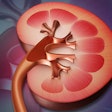
A new liquid biopsy method based on DNA methylation and powered by artificial intelligence (AI) demonstrated promising performance at classifying brain cancers and identifying whether kidney tumors were present in a pair of studies published online on June 22 in Nature Medicine.
The method -- called cell-free methylated DNA immunoprecipitation and high-throughput sequencing (cfMeDIP-seq) -- has been developed for blood and other kinds of liquid specimens. Testing screens for abnormal methylation, whereas liquid biopsy tests typically look for mutations, the researchers explained.
One study using the method to classify intracranial brain tumors was featured in a plenary session at the American Association for Cancer Research (AACR) virtual meeting, held from June 22 to 24, in addition to being published in Nat Med.
The study evaluated the method as an alternative to tissue samples taken during surgery, which can be particularly difficult to access for patients with brain cancer. The machine learning-driven method was developed for a range of solid tumors at the lab of Dr. Daniel De Carvalho, an epigenetics specialist and associate professor at the University of Toronto.
The study involved the development of cfMeDIP-seq profiles of intracranial tumors using plasma samples from 60 patients. These data were combined with other datasets for a total of 447 samples.
De Carvalho and colleagues reported high sensitivity for classifying gliomas, with an area under the receiver operating characteristic curve (AUROC) of 0.99. Performance was similar in patients who were IDH-mutant and wild-type, as well as lower-grade and high-grade gliomas, they noted. The DNA-methylation profiles revealed highly specific signatures of intracranial tumors, they reported.
"In the present study, we present the first application of our plasma-based liquid biopsy approach to detect and distinguish clinically relevant tumors of the central nervous system," De Carvalho and colleagues wrote. "We demonstrate that our approach, which does not rely on information obtained from a tumor tissue biopsy, can be used to distinguish gliomas from extracranial cancer types that may metastasize to the brain."
Managing patients better
Liquid biopsy has potential to fill a gap in the diagnosis and management of patients with intracranial tumors, as classification of types is currently challenging with imaging and invasive with surgery. Genomic analysis of circulating tumor cell-free DNA (ctDNA) has limitations on sensitivity, and a focus on DNA-methylation alterations has advantages, they noted.
"Reliable noninvasive strategies to diagnose and subtype tumors would be transformative for patient care, either by providing diagnostic information preoperatively that can improve neurosurgical planning or by avoiding the need for highly invasive procedures altogether," the authors wrote.
Plasma cfMeDIP-seq signals correlated well with corresponding tumor tissue DNA-methylation values overall, "suggesting that the signatures we identified to detect gliomas were in fact primarily derived from glioma DNA," the authors noted.
A second Nat Med study by De Carvalho et al evaluated the same method in differentiating healthy patients from those with kidney cancers.
The study evaluated samples from the following:
- 99 patients with early and advanced kidney cancer
- 15 patients with stage IV urothelial bladder cancer
- 28 healthy, cancer-free control subjects
Across all stages of renal cell carcinoma (RCC), the assay was highly sensitive, with an AUROC of 0.99 in plasma and an AUROC of 0.86 in urine samples, the authors reported. Performance in blood was nearly perfect; it was less accurate in urine but "can be improved through technical and computational optimization," they wrote. The researchers believe the data could help lead to the discovery of a screening tool for kidney cancers.
"An accurate, highly sensitive and specific noninvasive test, alone or in combination with imaging, could transform clinical management by enabling early detection of RCC and reducing unnecessary kidney biopsies and nephrectomies," the authors wrote.













